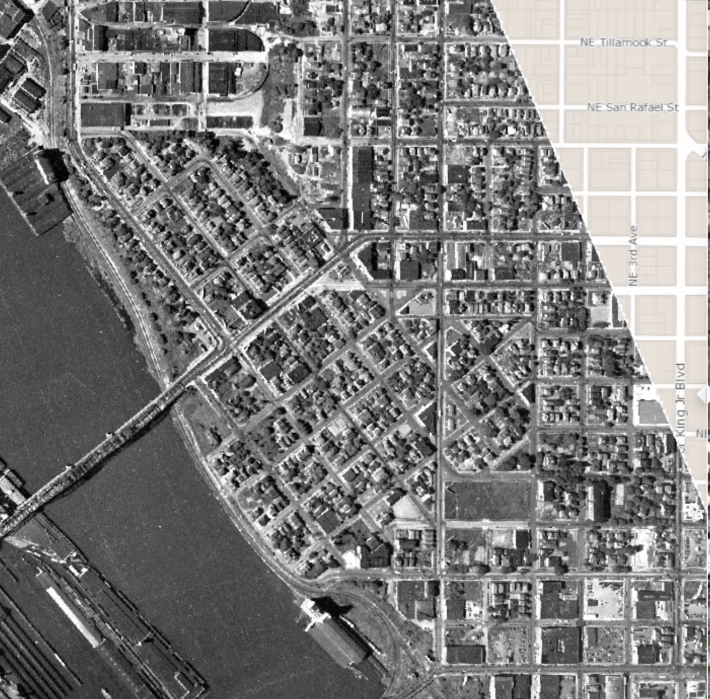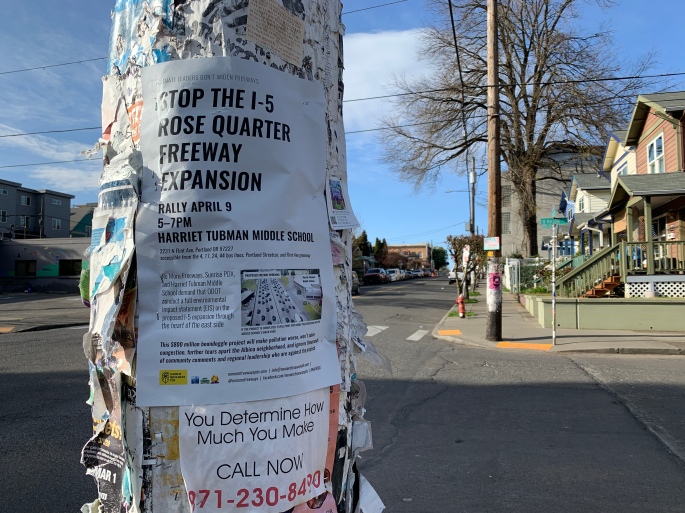Oregon Advocates Sue to Stop Racist Portland Highway Expansion
1:10 PM EDT on April 6, 2021

Another section of I-5. Image: Curtis Gregory Perry via Creative Commons.
Advocates in Portland, Ore. are suing to stop the expansion of an urban renewal era highway project — and possibly writing the next page in the playbook for fighting bad urban freeway redesigns across the United States.
Following recent revelations that the Oregon Department of Transportation had lied about the massive scale of a planned expansion of Intersatte 5, a coalition of grassroots community advocates on Monday filed a suit against federal highway authorities in U.S. District Court seeking to block the project because it violates the National Environmental Protection Act — "the Magna Carta of American environmental law," court papers say.
The suit argues that the federal government did not, as required by law, seriously consider alternatives to the $750-million "Rose Quarter Improvement Project," which would roughly double the width of a 1.5-mile section of the highway.
"Authorization of the project without preparing a [full] Environmental Impact Statement violates NEPA because the project is a major federal action significantly affecting the quality of the human environment," the suit argues.
Advocates hope legal action will be enough to force the agency to identify greener alternatives, but they've also reached out to US DOT Secretary Pete Buttigieg to request the Federal Highway Administration demand a more meaningful environmental review, echoing a successful effort by advocates in Houston to pause that city's own racist highway project last month.
Like countless freeways across the country, the construction of I-5 in the 1950s and '60s resulted in the deliberate destruction a large and prosperous Black community, in the case the Albina neighborhood, which lost approximately two-thirds of its population between 1950 and 1970. The project also cleared the way for a sports and entertainment district today known as the Rose Quarter.
As the region continues to grow, the state is seeking to expand the capacity of the Interstate, which would increase pollution and traffic violence upon the residents who remain — including students at the Harriet Tubman Middle School, whose student body is more than 53 percent Black and Latinx (in a city where just 15.5 percent of residents are Black or Latinx).
The expansion might also make it prohibitively expensive to build a cap over the freeway and devote the new land to restoring some of what Black Portlanders lost — something that nonprofit Albina Vision Trust has been fighting to do since the project began. The group withdrew its support of the project last summer.


The Oregon DOT and many Portland officials have been pushing for the Rose Quarter project since 2012, arguing that it will cure congestion and reduce emissions by cutting engine idling time in the fast-growing neighborhood. Advocates say both claims have been roundly debunked, and are based on flawed traffic modeling that ignores the basic principle of induced demand.
"ODOT deliberately put their fingers on the scale to say that this would be the first freeway expansion in history to help emissions and congestion," said Aaron Brown, an organizer with No More Freeways, one of the groups behind the lawsuit. (It should be noted that Oregon is far from the first state DOT to cite the popular myth that highway expansions are a boon to the environment and commute times.) "That was demonstrably false, and we proved it. The traffic engineers that we brought in said that if they handed these numbers to their bosses, they'd be fired."
Anticipated level of service isn't the only number that the agency has been accused of fudging. For years, ODOT refused to reveal details as simple as the width to which the road would be expanded, publicly presenting the project as nothing more than the addition of a few "auxiliary lanes" and road shoulders to the 84-foot roadway that would improve vehicle throughput by giving drivers more space to merge on and off the interstate, as well as better accommodate potential breakdowns.
But a public records request later revealed that the project would expand I-5 to a whopping 160 feet wide — enough space to accommodate 10 lanes of vehicle traffic, and far bigger than the 126 feet detailed in the agency's environmental assessment.

Following the revelation, ODOT quickly went on the defensive, suggesting the additional lanes might be used for bus rapid transit. In response, the local transit agency TriMet clarified that it had not requested the additional lanes, because it doesn't even run bus-on-shoulder service; in light of the statement, journalist Rachel Monahan remarked that Oregon DOT's offer was a little like "buying a birthday saddle for a kid who doesn't own a pony."
Some advocates wonder whether the highway department ever planned to deliver the transit agency its unwanted present — or whether gifting the BRT lane back to drivers was the plan all along.
"ODOT has never really defined what an auxiliary lane even is," said Joe Cortright, urban economics expert and the author of the City Observatory blog. "It doesn't matter what you call it — after you build a new lane, you now have a roadway that's wider. They could easily go in with a paint truck in an afternoon and redo it all."
The agency is also drawing outrage for another audacious claim about the Rose Quarter project: that it will become a catalyst for restorative justice in the region, because the agency will hire BIPOC contractors to handle the bulk of construction.
Some saw that as a slap in the face to the community at Harriet Tubman Middle School, which was already forced to spend millions of its scarce budget on an advanced air-cleaning system to mitigate pollution-related diseases in its student and staff population, thanks to their proximity to the highway. The Rose Quarter project may actually require building directly onto property currently owned by the school.
"There are these amazing middle school students that are getting on the news and saying, 'I should be doing homework and playing with my friends, but instead I'm trying to get ODOT to stop putting a highway in my recess yard,'" said Brown. "I mean, we're sending money to essentially subsidize rich car commuters and penalizing the lungs and school budgets of kids of color. Let's be honest here: ODOT isn't trying to put this in the backyard of wealthy white kids."

But pausing the project could prove challenging. If Buttigieg doesn't intervene and the lawsuit fails, the state could easily self-certify their environmental assessment and forge ahead with the project despite community objections — just like state DOTs across the country are consistently empowered to do when it comes time to "modernize" their federal highways.
"What we really need is to get US DOT is to tell states to set better standards for transportation modeling, so they can't keep underselling the carbon and commuting impacts of these projects based on their own math," said Cortright. "If USDOT says, 'you need to follow the science, and you need to account for induced demand in your modeling,' it would have a huge impact."
Still, Portland advocates are hopeful that with the new administration in Washington that's already fighting for dollars to repair the damage that the Federal Highway Act wrought, the Rose Quarter project could still be stopped — and if Houston's recent success is any indication, there are reasons to be optimistic that following a similar playbook could pay off.
"Freeway expansions are inevitable until they are not," said Brown. "The work we are doing now is to stop the worst of the 20th century, so the best of the 21st century can come forward. ... If we want to build the Green New Deal, we have to retire the gray old deal. We have to stop expanding these highways."
Kea Wilson has more than a dozen years experience as a writer telling emotional, urgent and actionable stories that motivate average Americans to get involved in making their cities better places. She is also a novelist, cyclist, and affordable housing advocate. She previously worked at Strong Towns, and currently lives in St. Louis, MO. Kea can be reached at kea@streetsblog.org or on Twitter @streetsblogkea. Please reach out to her with tips and submissions.
Read More:
Stay in touch
Sign up for our free newsletter
More from Streetsblog USA
You Wouldn’t Like Monday’s Headlines When They’re Angry
Which state has the worst road rage? Consumer Affairs magazine looked at a variety of factors to come up with an answer.
When it Comes to Federal Infrastructure Grants, Size Does Matter
Cities and municipalities with larger budgets and staff are more likely to win competitive federal infrastructure grants, the Urban Institute has found.
The E-Commerce Explosion is Making Roads More Dangerous
And can advanced technology stop the bloodshed?
Are Friday’s Headlines the New Normal?
Transit ridership hasn't come all the way back from the pandemic, and they're going to need more federal help, along with other changes, says Governing magazine.
Friday Video: How to Make Places Safe For Non-Drivers After Dark
A top Paris pedestrian planner, a leading GIS professional, and Streetsblog's own Kea Wilson weigh in on the roots of America's nighttime road safety crisis, and the strategies that can help end it.




